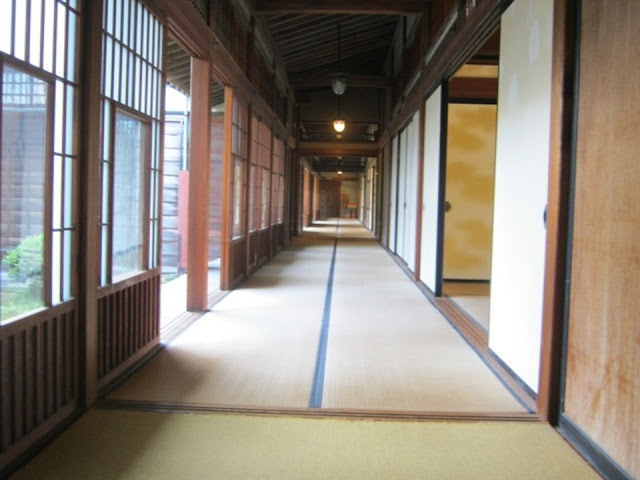Hofu is located in the western Japan and it faces Setonaikai (inland
sea). Mouri clan who was a warlord based here. It was also a provincial capital
in the ancient era, but for me, it is the hometown of Santouka who was a wandering
Haiku poet.
山口県防府市は、瀬戸内海に面し、毛利氏の拠点・三田尻御茶屋があった場所ですが、古くは、周防国の国府が置かれていました。私にとっては、敬愛する山頭火が生まれた町です。
Hofu cultural assets museum、防府市文化財郷土資料館
I visited here in 2017. It is a preservation facility of the cultural assets rather than a museum. An exhibition room is as large as a classroom, and it shows us the history mainly, but there are little exhibits about the entertainment of ordinary people. However, I was glad because a staff guided around one hour.
2017年に訪問。中心街の南側、小高い山(元は島)の近くにあり、展示施設というより、保存施設でした。防府の古代の歴史を中心に教室一つぐらいの小規模な展示室がありました。係の方に、一時間近く説明して頂いたのが嬉しかったですが、庶民の楽しみに関する展示は少なかったのは私にとっては残念でした。
The model of the residence of the provincial head: a hallway surrounds the rooms, and there are an office (left side) and a living space (right side) inside. It is so small.
国司の館のモデル:廊下に囲まれ、仕事をする表(左)と生活をする奥(右)があります。かなり狭いですねえ。
The site of the provincial office is been excavating even now.
国府跡は今も発掘中です。
The transition of a village interested me. It was needed long time for gathering houses and making a village.
下右田の集落の変遷:家々が長い時間をかけて、集まって住むようになりました。なるほど。
Official website: https://www.city.hofu.yamaguchi.jp/site/kankou-site/siryoukantop.html (in Japanese), accessed in October, 2020
Hofu city、防府市内
The tourist attractions: Suou Kokubunji (temple) was established in about the eighth century and it is located at the same place even until now. Suou Tenmangu (shrine) is the one of three greatest Tenmangus, along with Kitano in Kyoto and Dazaihu in Fukuoka. The view of the city from Shunpurou is excellent.
防府市の名所:国分寺が形を変えて、昔と同じ場所にあります。天満宮は北野、大宰府と並んで三大天満宮と呼ばれています。春風楼から市内の眺めが気持ちよいです。
My favorite tourist attraction is the place where we can see the relic of the house where Santouka (1882-1940) was born. He wrote Haiku poems such as;
“Wading through, And wading through, Yet green mountains still.”
(Wake-ittemo wake-ittemo Aoi yama)
“The cawing of a crow - I also am alone.” (Karasu naite watashi mo
hitori)
(http://www.lcv.ne.jp/~ibs52086/fire/)
He walked around Japan, especially Kyushu Island and drank large amount of alcohol. He was poor but lived freely. Therefore, his life
and poetry attract business people who work for living daily.
The road to the elementary school along the channel is called “Santouka’s
pathway” now. There are many channels in this city.
Reference (Santouka, Wiki): https://en.wikipedia.org/wiki/Sant%C5%8Dka_Taneda
私にとっての防府市の名所は、何と言っても、種田山頭火の生家跡です。「分け入っても分け入っても青い山」「鴉啼いてわたしも一人」など好きな句が多い。彼が小学校に通った道が「山頭火の小みち」となっていて、防府に多い疎水に沿って歩けます。英語での紹介は長くなってしまいました。
Eiun-sou、英雲荘
This
is also called Mitajiri-chaya (tea-house). The daimyo (Mouri clan) took a rest or treated
guests in this building. And this was also a base of Mouri to the inland sea.
After the daimyo system was abolished in the late 19th century, it
had been used as a villa of Mouri family. I wonder whether their life was enjoyable or
not.
萩藩の海への拠点・三田尻御茶屋であり、萩往還の起点でもあります。明治以降は毛利家の別邸として使用されました。大名の日々の暮らしは楽しいものだったのでしょうか。
The building in front is a living space and behind it has a viewing room of the sea.
奥座敷棟(手前、明治時代)と大観楼(奥、江戸時代):防府市中心街の南側、かつては海に近かった場所です。
The view of the daimyo’s official room from the subordinate’s room: the interior is excellent, however pictures got age deterioration. It’s difficult to keep the prosperity. These buildings were donated to the city.
大観楼の一階にある御書院の三の間から見た一の間、殿が居る場所です。雲居も凝っています。「控えおろう」って感じです。床のしつらえも立派で、左側が広い書院があります。しかし、絵などは傷んでいました。栄華を続けるのは難しいものです。今は、市が管理しています。
Suikinkutsu (水琴窟): this is a sink after washing hands, but it makes beautiful sound while the water is pouring. Because it has a big pot under the ground. When the water drops into the pot, a high pitch sound is made. It has an echo effect, too. The daimyo who made this is chic!
御書院側の庭には、柄杓で水を流すと上品な音が鳴る水琴窟。風雅な殿様がいたそうです。
I like this round window on the left. We might see a garden before the living space was built.
It is no doubt that the quality of equipment is high, however the
dominant factor in order to enjoy life is not to build an excellent house, I
thought here.
御書院側廊下の先にある円い窓。外には明治に作られた奥座敷棟が見えます。でも、江戸時代は、庭が見えていたのでしょう。この造りはいいですねえ。
上質な暮らしですが、殿が楽しかったかどうかは分からないですね。楽しさを決定づける要素は、住居の他にありそうです。
Official
website: https://www.city.hofu.yamaguchi.jp/soshiki/40/eiunnsou-riyouannnai.html
(in Japanese), accessed in October, 2020
Old main residence of Mouri、旧毛利本邸
Eiun-sou was built near the sea, but this mansion was built in the
mountain side in 1916. Loyalists of Mouri found the land and constructed. The
area is 84,000 sqm, the building area 4,000 sqm and 60 rooms which include the museum. By the way, the head of Mouri family lives in Tokyo according to the website.
英雲荘が防府市中心街の南側、海に近いのに対し、毛利本邸は山手にあり海を遠望します。毛利家が明治時代に英雲荘から居を移し、1916年(大正5年)に邸宅が完成しました。旧主への忠誠心が篤い井上馨らが土地を求めて造ったそうです。
毛利氏庭園(名勝)と旧毛利本邸(重要文化財)、本邸の一部が毛利博物館(国宝4件7点、重要文化財約9千点)、となっていて、見応えがあります。玄関までのアプローチや庭も素晴らしい(敷地84,000㎡、建物4,000㎡、60室)。ところで、ネット情報では、当主は東京に住んでいるようです。
Main building from the garden: the huge stone lantern is impressive.
庭園からの本邸:巨大石灯篭が印象的でした。
We can reach the entrance after walking long approach inside a big gate for ten minutes. There were very few visitors because it was a weekday. There is a ticket booth on the right.
玄関(手前の小屋は入場券売り場):巨大な門は玄関のずっと手前にあり、10分ぐらい広い道を歩いてここにたどりつきます。平日なので、人はわずかでした。
The main guestroom faces the garden.
庭に面した一階の大広間です。「百万一心」とも「一日一力一心」とも読める掛け軸があり、大きな書院が設けられています。
Proceeding the long hallway.
大広間の横の廊下を進みます。
The view from the Shoin-style room in the second floor widens our minds.
二階の大広間は眺望が良く、気持ちが晴れ晴れとします。
There are art works in the room. They met various people here, it might have been a peaceful life. But I guess it might be a bit boring.
書院には彫刻のようなものがありました。明治の元大名(毛利家は公爵)の暮らしは、平和ですが、退屈ではなかったのでしょうか。いろいろな人に会っていたと思いますが。
Emperors in the 20th century stayed at this room. It was a joyful trip for them. The Showa Emperor left a poem to praise the garden.
大正天皇、昭和天皇が宿泊した間。天皇陛下にとっては、大変楽しい旅だったと思います。「水きよき いささ小川の 流れゆく たたらの庭の 春のしづけさ」という昭和天皇の御製が残っていいます。天皇陛下をお招きするとは、さすが毛利家です。
Again, it’s a huge building.
東側からみた毛利本邸は巨大な屋敷と言うしかないですね。
The layout of the mansion: the bathroom is also huge. The marble tub is in it. 毛利邸平面図 (防府市Webサイト、毛利邸の情報豊富)
http://www.city.hofu.yamaguchi.jp/site/matsuzaki-kom/matukom-mouriteien.html
広大です。広い浴室では蛇口をひねると湯が出て、浴槽は大理石でした。
Mouri museum、毛利博物館
There is a museum in this mansion. I’m sorry that photography is prohibited. Historical documents especially in the Meiji restoration (Bakumatsu) will excite its fans.
Even I was excited by the secret letter below from the emperor to Mouri which was the direction to beat the Tokugawa shogun. It became true.
毛利邸の奥は毛利博物館があります。写真を撮れないのが残念ですが、維新の時の手紙などが展示されていて、幕末ファンには堪らないと思います。
毛利敬親に当てた討幕の密勅(上の写真、パンフレットから)には、「源の何某(徳川慶喜)は悪い、これを討て。この命令をおろそかにするな。」というようなことが書かれていたと思います。幕末ファンでもない私でも熱くなりました。
Official website: http://www.c-able.ne.jp/~mouri-m/ (in
Japanese), accessed in October, 2020
Two daimyo's funs(楽fun)were found. Visited in September, 2017
Previous post (Museum mainly about a puppet show in the western Japan, 徳島県):
Matsushige Historical Folk Museum and
Joruri Puppet Museum、松茂町歴史民俗資料館・人形浄瑠璃芝居資料館
Next post (Small
museum in the same prefecture):




















Comments
Post a Comment